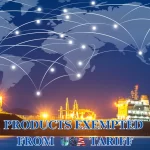Assessing the Impact of US Tariffs on India: A Closer Look at the Trade Dynamics
In a sweeping move that has sent shockwaves through global markets, the United States recently implemented a two-stage tariff strategy. Beginning April 5, 2025, a flat 10% duty was imposed on all imports, with additional country-specific “reciprocal tariffs” coming into effect on April 9.
Among the affected nations, India is slated to face a 27% tariff—a rate notably lower than those levied on competitors such as China, Vietnam, and Bangladesh.
A Modest Economic Impact
Despite the broad reach of these measures, several industry experts and economists suggest that India may be relatively insulated from severe economic disruption. Detailed analyses indicate that even under a worst-case scenario, where all major trading partners enact similar retaliatory measures, the projected GDP contraction for India would be minimal, around 0.19%.
On a household level, this could translate to an annual impact of roughly $28, which is considered negligible when compared to the potential fallout in other nations.
An alternative scenario, where other countries choose not to respond in kind, even hints at a slight positive effect, demonstrating India’s resilient economic fundamentals and a lower reliance on volatile external demand.
This resilience is attributed to the country’s robust domestic consumption, a moderate trade surplus with the US, and the comparatively low share of imports in its inflation basket.
Competitive Advantages Amid Trade Tensions
India’s position in the global trade landscape appears to offer a distinct competitive edge. With reciprocal tariffs on US goods set at 27%, Indian exports remain more favorably positioned than those from markets facing much steeper duties, for example, tariffs on Chinese and Vietnamese goods exceed 34% and 46% respectively. This “tariff arbitrage” enables Indian exporters to maintain price competitiveness, even as the broader tariff environment tightens.
Industry voices, including insights from economists like Sujan Hajra, highlight that even if exports to the US decline by up to 10%, the overall effect on India’s GDP would be contained. Moreover, the ongoing bilateral trade negotiations between India and the US are expected to help mitigate any adverse impacts over the longer term. By potentially securing tariff reductions or exemptions in sensitive sectors, both governments aim to sustain a mutually beneficial trade relationship.
Looking Ahead: Strategic Trade Negotiations
While uncertainty looms large in global trade, India’s proactive approach in negotiating a comprehensive trade deal with the United States could further cushion the impact of these tariffs. Experts believe that with a balanced agreement, India’s resilient domestic market and strategic export sectors, ranging from pharmaceuticals to textiles could even benefit from a realignment of global supply chains.
For Curated Exim, the key takeaway is that the US tariff regime, though disruptive on a global scale, may ultimately present an opportunity for India to strengthen its export competitiveness and secure long-term trade advantages.
How Curated Exim can help?
In these uncertain times, strategic use of government export-import schemes can make a significant difference in managing costs and staying competitive. Curated Exim specializes in helping businesses leverage schemes such as the Advance Authorization, EPCG (Export Promotion Capital Goods), and MOOWR (Manufacturing and Other Operations in Warehouse Regulations).




